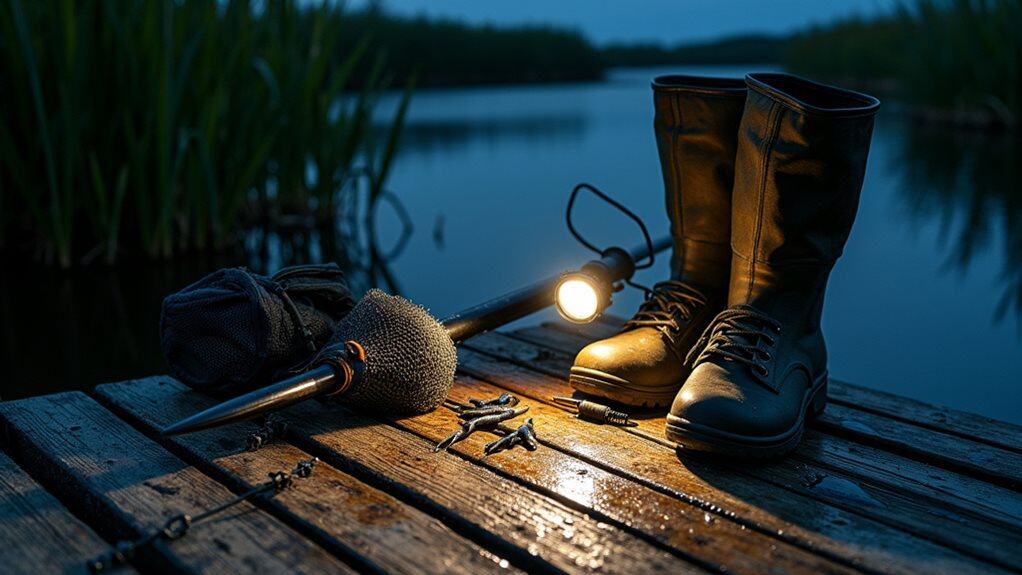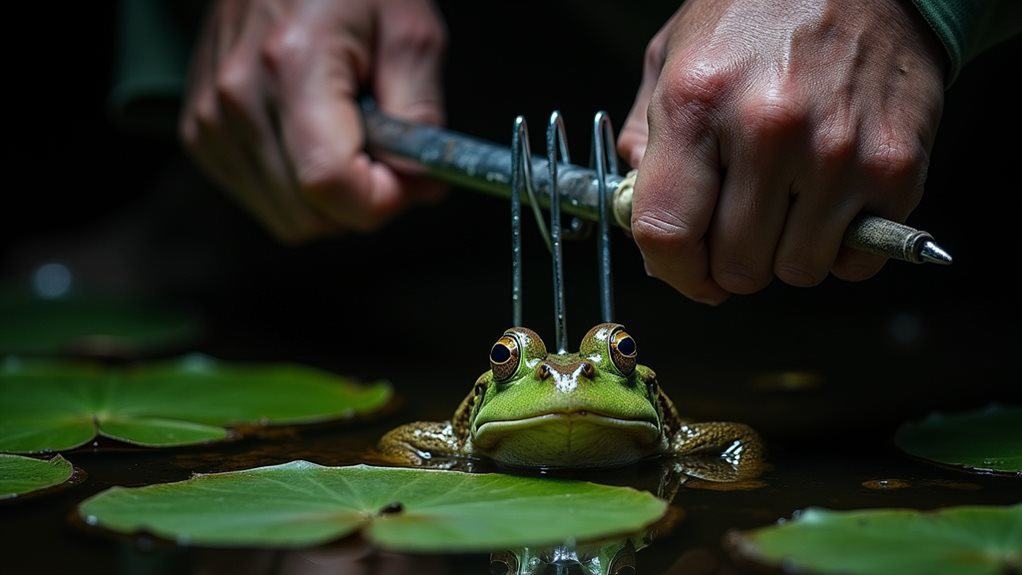You’ll need a quality frog gig with sharp tines, waterproof LED lighting, and protective clothing for successful frog gigging. Target shallow wetlands and pond edges during nighttime, moving silently to avoid spooking your quarry. Position yourself within arm’s reach before striking swiftly at the frog’s head base when only eyes are visible above water. Always follow local regulations, wear sturdy boots, and carry safety equipment like headlamps and flotation devices. Perfect these fundamentals to access advanced techniques that’ll greatly enhance your success rates.
TLDR
- Start with essential gear: sharp frog gig, telescoping pole, waterproof LED spotlight, frog bags, and waterproof clothing.
- Target shallow wetlands, pond edges, and slow streams with abundant vegetation where frogs gather to feed.
- Move silently with minimal lighting, scanning shorelines carefully to avoid spooking frogs before approaching within striking distance.
- Strike swiftly at the base of the frog’s head when only eyes are visible above water surface.
- Follow local regulations, wear protective gear, and practice conservation principles while maintaining proper catch preservation methods.
Essential Equipment and Gear for Frog Gigging

When you’re preparing for a successful frog gigging expedition, having the right equipment can make the difference between a productive night and coming home empty-handed.
You’ll need a quality frog gig with sharp stainless steel tines, a telescoping pole for reach, waterproof lighting like LED spotlights, frog bags for transport, and waterproof clothing for comfort. Kayaking with Kids can be an excellent family activity, especially when done in a safe environment. Professional froggers often prefer Ultra Light Headlights for their superior performance and portability during night expeditions.
Locating and Approaching Frogs in Their Natural Habitat
You’ll find the most productive frog gigging spots in shallow wetlands, pond edges, and slow-moving streams where frogs gather to feed and breed during nighttime hours. Regularly engaging in outdoor activities like frog gigging can provide numerous health benefits that enhance your overall well-being. Success depends on your ability to move silently through these environments, using minimal lighting while scanning shorelines and vegetation where frogs typically position themselves. These areas with abundant plant life create ideal conditions since frogs rely on the rich insect populations that thrive around aquatic vegetation. Perfecting these location identification skills and stealth techniques will considerably increase your chances of a successful gigging expedition.
Prime Frog Hunting Locations
Three key factors determine your success in locating prime frog hunting spots: consistent water sources, suitable habitat features, and ideal timing.
Target shallow waters with abundant vegetation, logs, and rocks near spring-fed streams or permanent water bodies.
Look for mudflats and marshy edges where frogs rest.
Green oases in dry environments often concentrate populations.
Stealthy Nighttime Approach Techniques
As darkness settles over the water, commanding stealthy approach techniques becomes the difference between a successful frog gigging expedition and an empty cooler.
Move slowly to avoid creating ripples that’ll spook your target. Shine your light directly into the frog’s eyes to momentarily stun them, then approach from behind using natural shadows for cover.
Proper Gigging Techniques and Methods

Once you’ve successfully located and approached your target bullfrog, the actual gigging technique becomes the critical moment that determines your success.
You’ll need to position yourself within arm’s reach of the frog while ensuring it remains in ideal striking position, typically when only its head and eyes are visible above the waterline.
The key to effective gig thrusting lies in one swift, decisive motion that prevents the frog from escaping once you’ve temporarily blinded it with your light beam. Additionally, proper fish handling and storage techniques are important to ensure a successful outing and maintain the quality of your catch.
Optimal Frog Positioning
Successful frog gigging hinges on your ability to position yourself ideally relative to both the frog and your environment, requiring a delicate balance of stealth, precision, and timing.
Approach from behind when possible, maintaining a foot’s distance before striking. Keep your light directly on the frog’s eyes to blind them, while positioning your gig tip three inches away for maximum accuracy.
Effective Gig Thrusting
Command the thrust itself, and you’ll change from a hopeful beginner into a skilled frog gigger who rarely misses their target.
Aim directly behind the frog’s eyes at the head’s base for a clean, humane kill. Use sufficient force to penetrate water quickly, but avoid excessive power that damages meat.
Follow through immediately by transferring your catch to an iced cooler.
Safety Precautions and Environmental Awareness
Before you head out with your gig in hand, understanding proper safety measures and environmental responsibilities will make your frogging experience both successful and sustainable.
Wear sturdy boots and synthetic clothing for protection, carry headlamps for visibility, and pack flotation devices when using boats.
Always follow local regulations, respect wildlife habitats, practice conservation by taking only what you need, and practice Leave No Trace principles to ensure the environment remains intact for future generations.
Identifying Target Species and Size Selection

When you’re out on the water with your gig, correctly identifying your target species is just as essential as perfecting your technique.
American Bullfrogs are your prime target, reaching up to eight inches with large eardrums and no dorsolateral ridges.
Green Frogs are smaller but common, displaying prominent ridges running from their eyes down their backs.
Handling and Processing Your Catch
Once you’ve successfully gigged your frogs, proper handling becomes essential for maintaining the quality of your catch and ensuring food safety.
Immediately secure frogs in a container with water to keep them moist. Dispatch them quickly and humanely, then store in an iced cooler.
Clean all equipment thoroughly to prevent contamination throughout the process.
Final Note
You’re now equipped with the fundamentals of frog gigging, from selecting proper gear to processing your catch. Remember that practice improves your technique, so don’t get discouraged if your first outing isn’t immediately successful. Always prioritize safety, respect local regulations, and practice sustainable harvesting to preserve frog populations. With patience and proper preparation, you’ll develop the skills needed to enjoy this traditional outdoor activity while contributing to wildlife conservation efforts.




